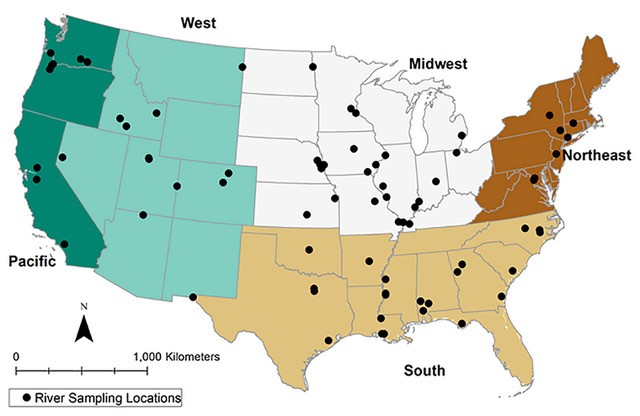04
Jun
Pesticide Pollution Continues Unabated, According to New Data

(Beyond Pesticides, June 4, 2021) The release of the most recent U.S. Geological Services (USGS) study of pesticide contamination of rivers on the U.S. mainland finds that degradation of those rivers from pesticide pollution continues unabated. USGS scientists looked at data from 2013 to 2017 (inclusive) from rivers across the country and offered these top-level conclusions: “(1) pesticides persist in environments beyond the site of application and expected period of use, and (2) the potential toxicity of pesticides to aquatic life is pervasive in surface waters.” Beyond Pesticides maintains that ultimately, water quality and aquatic organisms and their ecosystems will be fully protected from pesticides through a wholesale movement to organic land management practices.
USGS undertakes periodic assessments of the presence and toxicity of pesticides in the country’s surface waters under the agency’s National Water-Quality Assessment Program. Recent news from these studies has not been good. In September 2020, Beyond Pesticides reported on another, related USGS survey, which found that nearly 90% of U.S. rivers and streams are contaminated with mixtures of at least five or more different pesticides. A March 2021 Beyond Pesticides Daily News article noted that USGS research demonstrated that, of 422 water samples taken from streams across the U.S. over a five-year period, 95% showed contamination by at least one pesticide.
As the number of pesticides in waterways increases, it has detrimental impacts on aquatic ecosystem health, especially as some pesticides have synergistic impacts in combination, amplifying negative effects. In addition, many aquatic organisms, such as algae and fish, are threatened even at low levels of pesticide exposure. For details on such impacts, see the “Summary of Findings” in Beyond Pesticides’ paper, Poisoned Waterways. it also writes about the multiple issues related to pesticides and water quality; the under-examined impacts of pesticide breakdown products in waterways; and the serious concerns about pesticides in surface waters used as sources of public drinking water.
The researchers’ goals for this current study were: (1) to offer national and regional estimates of (a) pesticide-use data, (b) detection frequency of 221 pesticide compounds, and (c) potential toxicity of these pesticides to aquatic biota and human health; and (2) to investigate impacts of human activity on surface water quality by examining the relationship between agricultural pesticides use and surface water concentrations. If there were a single, net takeaway from this study, it might be this: detected pesticide levels across all the sampled sites and compounds correlate highly with intensity of pesticide usage in the basin/watershed of the sampled surface river waters. The add-on to that is that the chronic exceedances of benchmark levels (thresholds above which negative outcomes are expected) for particular pesticides, and the extent of pesticide contamination of surface waters, are alarming.
Published in mid-April 2021 in Science of the Total Environment, the study quantified concentrations of 221 compounds — 57 herbicides, 38 insecticides, 11 fungicide parent compounds, and 115 pesticide degradates (breakdown products). Herbicides constitute 88% of the total pesticide use represented in the sampling. The researchers assess potential toxicity of the various compounds by comparing the pesticide concentrations in river (surface water) samples to standard concentrations (benchmarks) considered to affect human health or aquatic organisms negatively.
As the paper notes, “Benchmarks are a critical element of all ecological assessments, and USEPA and USGS have assembled rigorous set of benchmarks for an analysis of pesticide risk to human health and aquatic life. However, the benchmarks based on toxicity tests conducted in the laboratory may not fully reflect the risk to field populations.” For the study’s purposes, a collection site was understood to have a “benchmark exceedance” for a given pesticide within a given water year when the 60-day moving average concentration was greater than the method detection level for that pesticide and greater than the benchmark concentration.
The study sampled water (via 12–24 samples annually) from 74 river sites across the five regions it identified: the Northeast, South, Midwest, West, and Pacific (see map below). (Collection of samples was more frequent from April through September — periods of high pesticide use and runoff.) The study uses this regionalization of data because much pesticide contamination of surface waters happens via agricultural activity, which varies widely across the mainland. Given that, the scientists reasonably expected that differences in crop production would cause variability in pesticide use, detection frequency, and benchmark exceedance patterns. The regionalization of the data enables the scientists to assess whether water quality issues related to pesticides are pervasive or isolated to a particular region.

Most collection sites have drainage areas so large that their water quality reflects mixed sources of pesticides from multiple land-use categories. No one site reflects only an agricultural, or a developed, land use. However, a dominant use category, capturing the prevailing use in each watershed, is defined for each collection site. Thirty-two are deemed agricultural, 13 are urban, and the 27 other sites reflect mixed use.
The researchers also note that the contributions of urban/developed areas to the presence of pesticides in river surface water is tricky to sort out. Although urban landscape pesticide “contributions” are relatively small compared with those from dominantly agricultural areas, the researchers posit that for insecticides, the contributions may be more significant. They write: “Unlike agricultural use, for which we have a reasonable estimate, the amount of a pesticide applied in an urban setting is not possible to estimate, as few records of use in this setting are available. . . . Elevated surface water concentrations, particularly of insecticides like fipronil, diazinon, and carbaryl, have been documented in rivers draining [urban] watersheds.”
The paper highlights additional findings. At least one pesticide is detected at 71 of the 74 sampling sites; an average of 17 discrete pesticides are found at each site; and 75% of the detected pesticides have not been measured in previous USGS national-scale assessments. Herbicide and fungicide use intensity is significantly higher in the Midwest than in the other regions, and intensity of use is significantly greater in the South, Midwest, and Pacific regions than in the Northeast and West. Although agricultural pesticide use is at least 2.5 times greater in the Midwest than in any other region, and the number of pesticides detected in Midwest samples is 1.5 times greater, potential toxicity results are distributed more evenly across regions.
The highest rate of detection frequencies (DFs) for the most-detected herbicides (atrazine, metolachlor, and 2,4-D) occurs in the South and Midwest, with 2,4-D appearing for the first time in a USGS national-scale assessment. (Several other compounds also appear for the first time in USGS research, underscoring the co-authors’ point that periodic updates to the list of pesticides included in assessments are critical.) DFs for insecticides and fungicides are, across the board, much lower than those for herbicides. Noteworthy is the fact that the insecticides found most frequently in this study’s sampling — acephate, imidacloprid, and carbaryl — are currently banned in Europe.
The study deals with two categories of benchmarks — aquatic life benchmarks (ALBs) and human health benchmarks (HHBs) — though within those exist subset benchmarks (e.g., fish benchmarks or invertebrate benchmarks). At least half of the sample sites within each of the regions have at least one chronic benchmark exceedance, with imidacloprid representing the gravest potential threat to aquatic life: it totals 245 ALB exceedances (out of a maximum of 370) at 60 of the 74 sites. The study data show that imidacloprid, metolachlor, and atrazine clock by far the highest number of benchmark exceedances over the data years.
The researchers write, “These results show that pesticides persist in the environment beyond the site of application and expected period of use. . . . [and] illustrate the value of multi-year, national-scale monitoring of pesticides in surface waters, as we were able to capture this chronic and widespread pesticide threat through a range of concentrations from multiple sites and years.”
Between 80% and 100% of sampling sites in the Northeast, Midwest, and South have at least one site with a pesticide exceeding a chronic invertebrate benchmark; for the West and Pacific regions, that metric is lower (50% and 67%, respectively). Researchers found two herbicides, atrazine and metolachlor, present in concentrations high enough to exceed chronic fish benchmarks; metolachlor also exceeds chronic benchmarks for invertebrates. Herbicides with plentiful (12 to 33) benchmark exceedances, including acetochlor, atrazine, and metolachlor, are heavily used and consistently detected at elevated concentrations. These herbicides also exceed benchmarks across a range of taxa, including plants, fish, and invertebrates.
The co-authors write: “The high number of chronic benchmark exceedances indicated that the threat of pesticides to aquatic life across the [mainland U.S.] can be persistent. Even with limited sampling, our benchmark exceedance analysis indicated that transient high pesticide concentrations can result in the exposure of aquatic organisms to acutely toxic conditions across all regions of the [conterminous U.S.].”
These documented threats to aquatic organisms and ecosystems, and to human health — particularly given the persistence of pesticide compounds in surface waters — should be of concern to all. Transitioning to organic land management practices, especially in agriculture, but in all turf and landscape management, is the path toward a nontoxic future and healthy, optimally functioning ecosystems of all kinds.
Read our factsheet, Organic Land Management and the Protection of Water Quality, or download the shorter brochure version for more on how organic practices can protect water quality. To learn more about pesticides and water quality, see the Beyond Pesticides website page, Threatened Waters: Turning the Tide on Pesticide Contamination. For closer-to-home concerns, see Pesticides in My Drinking Water? Individual Precautionary Measures and Community Action.
Source: https://www.sciencedirect.com/science/article/pii/S0048969721022178
All unattributed positions and opinions in this piece are those of Beyond Pesticides.










